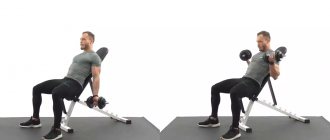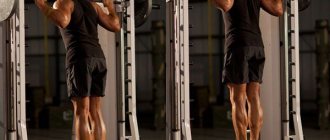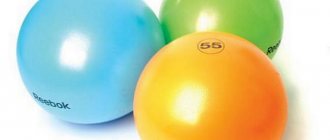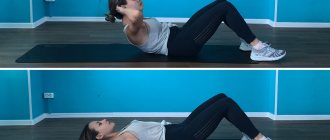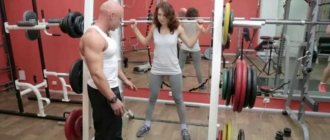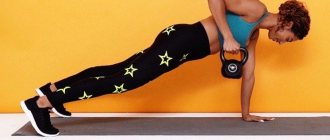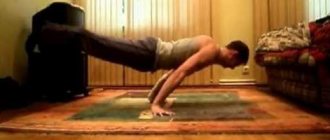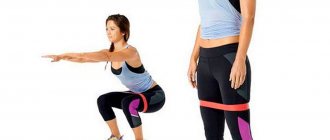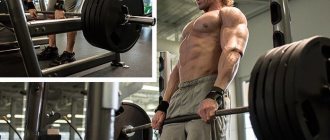Professional-level fitness trainers working in the field of fitness recommend performing abdominal exercises on a fitball. Their high efficiency has already been proven in practice. This is explained by the fact that during the execution the athlete is completely focused on the position of his body, the muscles involved, breathing, and movement. It only takes a little distraction to lose your balance.
In addition, almost all muscle groups are involved in the work, including stabilizers. Fitball is no less accessible training equipment than dumbbells. But the ball will force you to work in a different direction. It affects many muscles during the training process, since almost all exercises are designed for a sense of balance. It is this that forces us to maintain balance, which keeps various muscle groups in tension not only in the abdominal area, but also in the legs, arms and body as a whole. It’s worth learning more about how to properly create a load using this projectile. This will help diversify the workout for everyone who wants to lose weight and get their body in order completely, not only in the area of “cubes”.
Ball selection
Anyone can do exercises on a ball for the abs and buttocks, and there are no exceptions. The main thing in this matter is to choose the right ball that will suit the athlete’s height.
- If the height is less than 1.65 m, the projectile must have a diameter of no more than 60 cm.
- Height from 1.65-1.75 m – ball diameter 65 cm.
- The height is more than 1.75 m - the diameter of the projectile is 70 cm.
Only the correctly selected ball size will tidy up the abdominal area and reduce your waist size. You will be able to perform all sorts of exercises on it.
Lumberjack Diagonal Squats
Stand with your feet hip-width apart, knees slightly bent, and hold the medicine ball with both hands. Lower yourself into a squat by pushing your chest forward and driving the ball toward the outside of your knee. Stand and twist your body as far as possible, lifting the ball over your opposite shoulder. Return to the starting position. Do 8-12 reps on one side, then switch sides.
Basic ball exercises
The goal is to strengthen and develop the abdominal muscles. There are several options for performing this movement on the ball, which go more like a complex from simple to complex exercise:
- You need to sit on the ball. Cross your arms over your chest. Place your feet on the floor. Take small steps forward so that the fitball gradually rolls under your back. The head is held up. Make movements from this IP. First raise your head, then your neck, and then your shoulders. At the same time, tension in the press should be strongly felt. Hold this way for a few seconds, and then slowly return to IP. Do about 8 repetitions in two sets. The load is increased gradually as the body gets used to this type of training.
- IP as in the previous one. Place your hands on the back of your head, but do not cross your fingers. The exercise is performed in the same way as the previous one. You can't help him get up with his hands. 12 reps, 3 sets.
- IP: as in the previous ones. Extend your arms above your head, pressing your forearms to your ears. Take weights - dumbbells, a basketball or other object weighing no more than 3 kg. 12 repetitions in 3 sets.
Each type of ball exercise requires practice. How to properly pump up your abs on a fitball can be seen in many videos that show training with this equipment. If painful sensations arise during the process, the process is not proceeding correctly, incorrectly. Therefore, you need to start with the first type of movement on the ball, after which you can add the second as you get used to it, and then only the method with weights.
Video
What are the benefits of fitball?
Fitball has many names. It is called a Swiss ball, a gymnastic ball, a fitness ball. But this does not change the essence. The use of this equipment allows you to diversify your training regimen, make classes more interesting and enjoyable, which has a positive effect on their effectiveness. In addition, the benefits of such activities are also great. A fitball for the waist and abs can be very effective.
It allows you to work those muscles that, as a rule, do not work, or work very weakly. This especially applies to the “muscle corset,” that is, those muscles that support our correct and healthy posture. Exercising with a ball will force you to constantly balance. This puts a lot of stress on the abdominal and back muscles, both small and deep, which are weakly loaded during other exercises.
Ab exercises on a fitball help improve coordination, stability, and stability. These skills help prevent falls, which can lead to serious injuries.
Massage fitballs are especially good. They make it possible to get the maximum benefit. Massage elements additionally act on the muscles, relieving their tension and fatigue. Massage also improves blood circulation and restores skin tone.
Exercise on the ball No. 1
The goal is to develop the oblique and rectus abdominis muscles. IP: sit on a fitball, bend your knees and place your feet on the floor. When making small checkers, move the ball under your back. Place your right hand behind your head. Next, do the following movements on the ball:
- Sharply lift your pelvis up.
- The stomach must be pulled in.
- Raise your shoulders using your abdominal muscles.
- Turn your right shoulder to the left.
After this, return to the IP. Do 8 repetitions, then change sides. Do it in three approaches.
Stretching for the abdominal muscles on a fitboy
At the end of the block, do a stretch.
- Rise to your knees, placing them in line with your shoulders, tighten your abdominal muscles.
- Hold the sphere with your hands next to you.
- As you exhale, roll it forward as far as your arm length allows.
- Hold at the end point for 5 seconds.
The biomechanics of movements are similar to the roller technique.
Exercise on the ball No. 2
The purpose of the waist ball exercise is to develop and strengthen the hip flexors and abdominal muscles. The abs on a gymnastic ball are worked out a little less with this exercise if you do not carefully monitor the range of motion.
IP: lie on your back. Hold the ball between your ankles. Legs straight. Throw your hands behind your head, grabbing any support point. Pull your knees towards your chest. Try to hold the ball with your feet. Lift your buttocks off the floor for a few seconds. Then back to the IP.
To lift your legs, use only your abdominal muscles. The lower back does not bend during execution. Do 12 repetitions at the very beginning. Then, as you get used to it, you can increase the number of approaches from one to two, three, etc.
LiveInternetLiveInternet
A fitball or Swiss ball is almost the first sports equipment that is recommended for anyone who wants to get into good athletic shape.
In addition, exercises on a fitball are a truly effective solution for losing weight.
The ball can be used for cardio exercises, to develop strength and acquire a slender, toned figure, and to develop balance. By performing the necessary specific exercises for certain areas, you can pump up the muscles of the abdomen, hips, arms and give your figure a great, toned shape.
Today we will look at how you can pump up your abs and tighten your stomach using a fitball.
A set of abdominal exercises
1. Reverse crunch on the ball . Starting position: lie on your back, bend your legs 90 degrees, grab and hold the fitball with your feet, and place your hands under your back, palms down. Pull your knees toward your chest, lifting your pelvis. Return to the starting position without touching the ball to the floor. During the exercise, the angle of the legs does not change; movements occur due to the pelvis. Repeat the exercise for the required number of approaches and times. develop .
Remember, you should try not to swing your legs so as not to damage the muscles during the exercise.
2. Lower abs. Starting position: sit on the floor, holding a fitness ball between the soles of your straightened legs, lean back slightly and place your hands on the floor. Pull your knees toward your chest as much as possible while holding the ball, then extend your legs. Make sure that the ball does not touch the floor, that the stomach is taut and its muscles are tense. Repeat the exercise for the required number of approaches and times. develop .
3. Spinal twist. Starting position: lie on your back, bend your knees, the ball should lie motionless under your calves, spread your arms to the sides. Lower your legs down to the left of the ball until your knees touch the floor, while keeping your back and ball motionless. Return to the starting position. Repeat the exercise for the required number of approaches and 1/2 the number of times. Repeat the exercise for the required number of approaches and 1/2 the number of times, lowering your knees to the right of the ball. The oblique abdominal muscles develop .
4. Crunches on the ball. Starting position: lie on your back, squeeze the ball with your feet, lift your straight legs vertically up, put your hands behind your head. Pull the elbow of one hand towards the knee of the opposite leg, which takes a “step” towards, while the other leg remains motionless. Make sure that your chin is not pressed to your chest, and that the shoulder of your leading hand is lifted off the floor. Return to the starting position and repeat with the other arm and opposite leg. Repeat the exercise for the required number of approaches and times. The lower and oblique abdominal muscles develop
5. Rolling the ball. Starting position: kneel down, place your left hand on your waist, place your right hand on top of the ball. Keeping your stomach tight and your torso parallel to the ball, use your right hand to roll the ball forward so that your body follows it, then roll the ball back with your hand, returning to the starting position. This is a very difficult exercise, because... The hips and torso should be parallel to the ball, which is rolled only by hand. Repeat the exercise for the required number of approaches and half (1/2) the number of times. Change the position of your hands and repeat the exercise the same number of approaches and times. develop .
6. Twisting on a stationary ball. Starting position: lie on the ball so that your feet are on the floor and your thighs are parallel to the floor, cross your arms over your chest. Stretch forward as much as possible, raising your shoulders above the ball and not tilting your chin towards your chest. Return to the starting position by pressing your back into the ball. Remember that the stomach should always be tucked up and its muscles tense. Repeat the exercise for the required number of approaches and times. The rectus abdominal muscles develop
7. Direct twisting to the sides. Starting position: lie on the ball so that your feet are on the floor and your thighs are parallel to the floor, cross your arms over your chest. Raise your torso by twisting to the right, then return to the starting position. Raise your torso, turning to the left, and return to the starting position again. Make sure that your lower back does not come off the ball, and that your chin does not stretch forward or lean towards your chest, i.e. do not strain your back and neck muscles, only your abdominal muscles work. Repeat the exercise for the required number of approaches and times. develop .
8. Log with tackles. Starting position: place your palms on the floor, place your feet straight on the ball. Bend your legs, pulling your knees towards your chest while rolling the ball towards you. Return to the starting position by rolling the ball with your feet. Make sure your back, arms and head remain motionless. When rolling the ball, point your knees one way or the other if you want to use the obliques. Repeat the exercise for the required number of approaches and times. The abs, back, hips develop
9. Lateral bends. Starting position: lie on the ball sideways, feet resting on the floor, hands folded behind your head. Raise your torso sideways up to the maximum height. Return to the starting position. Make sure that your elbows are spread out to the sides, your legs remain motionless, and your torso moves in the same plane, without leaning forward or backward, and do not strain your neck muscles. Repeat the exercise for the required number of approaches and 1/2 the number of times, then turn over to the other side and repeat the exercise the same number of approaches and times. Target area: obliques, lateral abdominal muscles.
10. Straight side twist with the ball. The exercise is similar to exercise No. 7, only you should hold the ball in your hands, pressing it to your chest. Weights weighing more than a kilogram should not be used. When performing the exercise, do not forget that the abdominal muscles must be tense, only then will your exercises be effective. Repeat the exercise for the required number of approaches and times. The rectus and oblique abdominal muscles develop
11. Push-ups on the ball. The exercise is similar to exercise No. 8, only when bending the knees are directed straight to the floor, and the arms are bent. When rolling back the ball, you should straighten your arms. Try to bring your legs as close to your chest as possible while rolling the ball, do not relax your abdominal muscles. Repeat the exercise for the required number of approaches and times. Target area: triceps, chest, abs.
12. Bridge on the elbows. Starting position: bend your elbows and rest your forearm (the area from the wrist to the elbow) on the fitball, put your feet on your toes, while your neck, back and legs should form a straight line, pull up your stomach and hold this position for 8-12 seconds. Return to the starting position and repeat the exercise 2 more times. This exercise perfectly strengthens your abs.
13. Alternating lifting of arms (version 1) Starting position: rest your palms on the floor, place your feet on the ball. Raise your left arm above the floor so that it forms a straight line with your torso. Return to the starting position. Make sure that your neck, back and legs are in a stationary position and your stomach is tucked. Repeat the exercise for the required number of approaches and 1/2 the number of times, then change the supporting hand and repeat the exercise the same number of approaches and times. Target area: abs, back, shoulders.
14. Alternate raising of arms (var. 2) Complicated exercise No. 13, the difference is that the hand that was raised above the floor does not return to the floor, but is fixed on the belt, then again stretched forward and again placed on the belt without touching the floor . Repeat the exercise for the required number of approaches and 1/2 the number of times, then change the supporting hand and repeat the exercise the same number of approaches and times. The abs, back, and shoulders develop
15. Swing dumbbells on a ball. Starting position: take weights in your hands (dumbbells or plastic bottles filled with water or sand), lie with your shoulders and neck on the ball, stretch your arms in front of you, place your feet on the floor so that your shins are perpendicular to the floor. Spread your arms with weights (dumbbells): right up (behind your head), left down so that your arms become parallel to the floor, return to the starting position, spread your arms again, now left up and right down. Return to the starting position. Make sure that your arms are always straight, your stomach is tucked, and your neck, torso and legs are motionless. Repeat the exercise for the required number of approaches and times. The abs, chest, shoulders develop
16. Dumbbell swings with leg raises. Complicated exercise No. 15, the difference is that when the right arm is raised, the right leg is simultaneously straightened, when the left arm is raised, the left leg is straightened. The torso and head remain motionless. Repeat the exercise for the required number of approaches and times. Target area: abs, chest, shoulders, legs.
17. Bridge with alternating legs . Starting position: lower your palms to the floor, place your toes on the ball. Raise your straight right leg up over the ball and hold this position for 1-2 seconds, return to the starting position, lift your left leg up, hold it for 1-2 seconds. Return to the starting position. It is important that the arms, head and torso are motionless and the stomach is tucked. Repeat the exercise for the required number of approaches and times. The abs, back, legs develop
18. Balancing on your knees. Starting position: kneel on the ball, spread your arms to the sides and tuck your stomach. Balance in this position for 8-12 seconds. This is a difficult exercise and until you can maintain your balance, try to perform this exercise close to a table, sofa or other support. Repeat the exercise 2 more times. Target area: abs, back, shoulders.
19. Tackling the ball with one foot. Starting position: place your palms on the floor, place your legs straight on the ball. Roll the ball towards you with your right foot, while keeping your left leg with your back and neck in a straight line, roll the ball back, returning to its original position, then roll the ball with your left foot. Return to the starting position. It is important that the back, neck and arms remain motionless and the stomach is taut. Do not bend the leg that remains hanging. Repeat the exercise for the required number of approaches and times. Legs, back, abs develop
.
Starting position: lie with your shoulders and head on the ball, place your feet on the floor, shins perpendicular to the floor surface, spread your arms to the sides. Straighten your right leg, while the rest of the body remains motionless, the stomach is tucked in all the time. Return to the starting position. Repeat the exercise for the required number of approaches and 1/2 the number of times, then change the supporting leg and repeat the exercise the same number of approaches and times. Target area: abs, back, legs.
21. Stretching the abdominal muscles. Starting position: lie on the ball with your lower back and shoulders, lower your feet to the floor, shins perpendicular to the floor surface. Place your hands behind your head, trying to reach them towards the floor as much as possible. Return to the starting position. Repeat the exercise for the required number of approaches and times. This is a good exercise for stretching and relaxing after working out your abdominal muscles. It is useful after completing a set of exercises.
22. Lower back stretch. Starting position: lie with your pelvis face down on the ball, toes resting on the floor, feet shoulder-width apart, hands behind your head, elbows apart. Raise your shoulders above the ball, bending backwards. Return to the starting position. It is important that the neck does not tense, the chin does not stretch forward or lean towards the chest, and the legs and pelvis remain motionless. Repeat the exercise for the required number of approaches and times. This exercise will help strengthen your lower back . The tension is balanced between the lower back and the abs, so repeated execution gives noticeable results.
It is not necessary to perform all the exercises of the complex at once. After reviewing the proposed exercises on a fitball, you can choose a set of exercises that is right for you.
The selected exercises should be repeated at least 2 times a week for 1-2 sets of 15 repetitions. You should rest 1-2 minutes between repetitions. Gradually the number of approaches can be increased to 25.
Fitball gymnastics is suitable for almost everyone! So be healthy and beautiful!
See also:
Fitball: 20-minute butt workout
How to remove fat from the sides and lower back
A toned body in 10 minutes a day
Ball exercise No. 3
The goal is to pump up the muscles of the buttocks, mid-back and abs on a rubber ball. IP: kneel (the body is located at a right angle to the floor). Clasp your hands together. Place your hands on the surface of the fitball so that the position of your hips is maintained. Next, slowly roll the fitball forward. When the body is already at 45 degrees in relation to the floor, stop, inhale and draw in the stomach. The spine does not bend. Then you continue to roll the ball away from you again until the tension in the abdominal muscles becomes quite noticeable. After this, return carefully and slowly to the IP. 15 repetitions in 3 sets.
Important! Control every movement during the execution so as not to lose your balance. This may result in injury.
How to stay motivated to exercise
The result largely depends on the regularity of classes. But, alas, most of us are too lazy to exercise regularly. Planning often helps to maintain motivation - plan your workouts in all the smallest details: think about what form you will wear, what sneakers you will wear, what equipment you will need for exercise. In this way, psychologists say, you will trick your brain because you will simply get used to the idea of training, it will no longer be something new and scary for you. It's also helpful to think about why you're doing it. Strong muscles improve metabolism. Therefore, by regularly strengthening them, you speed up the weight loss process. “Whoever wants to take care of the muscular system responsible for metabolism and hormonal metabolism must adhere to one single rule: allow the muscles to do what they most like to do - move,” explains Andreas Stippler, physiologist, trainer and author of the book “Muscles.” , How are you?" . “Then long-lost strength will return, blood circulation will improve, pain will disappear, and previously flabby muscles will again begin to communicate with other organs of the body. Muscular movement is a measure of prevention and healing in the best and broadest sense.”
Think about this the next time you plan to skip a workout.
Fitball exercise No. 4
This ball exercise develops and strengthens the abdominal muscles. IP: lie on your back, lift the fitball above your head. Legs and arms are straightened. Use your abdominal muscles to lift your body (upper part) until the fitball is between your legs, which will clamp it. Then, along the same trajectory, you return to your back, simultaneously raising your legs with the ball sandwiched between them. Take the fitball in your hands again and move it behind your head, and return your legs to the IP. 12 repetitions, 2 sets.
Video
How to properly exercise with a fitball?
There are many exercises that allow you to lose weight and maintain muscle tone. The main thing to consider is that some of them require the use of a fitball with a different diameter - larger or smaller. To get the most out of it, you need to select the appropriate size balls.
The level of physical fitness directly affects the number of approaches and repetitions. The best option is to perform 3-5 sets of 10-20 repetitions for each exercise. You can increase the load after just a few workouts. If no problems arise with the execution of the training, then the pace is chosen correctly.
Ball exercise No. 6
This exercise will give you a complete stretch and relax tense muscles in your body. IP: sit on the fitball. Place your feet some distance away. Relax your hips, lower them so that your back, lower back, and pelvis rest on the surface of the fitball at a slight angle. Bend your knees and spread your feet slightly apart. As you inhale, straighten your legs and bend into an arch. The fitball should be under the buttocks and back. Feet firmly on the floor. Exhaling, move your hands behind your head. Try to touch the floor with your fingertips. Stay in this arched position for half a minute, and then sit down again.
Please note: Exercises with a fitball require special concentration from the trainee. Therefore, pay close attention to the exercises and execution technique so that exercises on the ball for the abs and buttocks are beneficial and do not end in injury. Thanks to this, you will work out almost your entire body and get a beautiful figure much faster.
It must be remembered that incorrect or too fast execution of movements can lead to spinal injuries. You should also carefully monitor your balance. It is recommended to do basic movements at first, and only then move on to advanced levels.
What muscles are involved?
In short - everything. Yes, yes, all the muscles take part during training with such a projectile. But, first of all, the abdominal muscles are involved. When the surface is unstable, people tense these muscles to maintain stability and not fall. Other muscles will also be used to perform different exercises.
Many women know how difficult it is to pump up their lower abs. There are few exercises that are effective for this muscle group. By performing abdominal exercises with a fitball, this problem will quickly disappear for women. You can train them simply by sitting on the ball. When trying to stay on the ball, the muscles of the body are in tension, and microvibrations from the surface of the projectile additionally stimulate muscle work. Due to this, female muscles are trained.
Read also: Overalls for a ballerina: what clothes are needed for ballet
Hand plank with medicine ball
Start in a plank position with a medicine ball near your feet. Slowly place one foot on the medicine ball and then the other to maintain balance. Stay in this position for 30-60 seconds.
Hard version: Start in a plank position with your feet resting on a medicine ball. Pull your right knee toward your chest and then return your leg back to the medicine ball. Then pull your left knee up and return to the starting position. Continue at a fast pace and remember to balance.
Body twists with medicine ball
Start sitting on the floor, legs bent at the knees, on the floor, medicine ball near your chest. Lift your feet off the floor. Rotate your torso to the right, as if you were throwing down a medicine ball, and turn your knees in the opposite direction. Return to center and then twist your torso to the left, knees slightly to the right - but do not touch the ground. Repeat 8-12 times.

